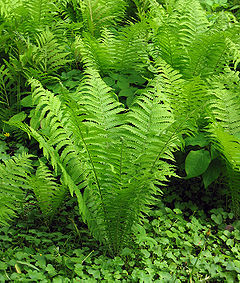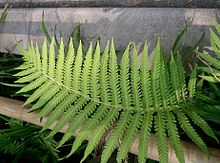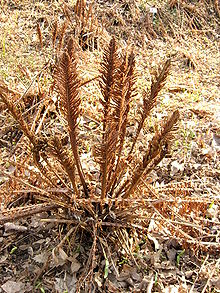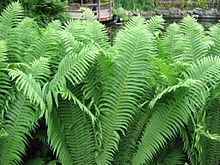- Matteuccia struthiopteris
-
Ostrich fern 
Sterile fronds in summer Scientific classification Kingdom: Plantae Division: Pteridophyta Class: Pteridopsida Order: Polypodiales (unranked): Eupolypods II Family: Onocleaceae Genus: Matteuccia Species: M. struthiopteris Binomial name Matteuccia struthiopteris
(L.) TodaroSynonyms - Matteuccia pensylvanica
- Matteuccia pennsylvanica (common misspelling)
- Onoclea struthiopteris
- Pteretis nodulosa[2]
The ostrich fern or shuttlecock fern (Matteuccia struthiopteris) is a crown-forming, colony-forming fern, occurring in temperate regions of the Northern Hemisphere in eastern and northern Europe, northern Asia and northern North America.
It grows from a completely vertical crown, favoring riverbanks and sandbars, but sends out lateral stolons to form new crowns. It thus can form dense colonies resistant to destruction by floodwaters.
The fronds are dimorphic, with the deciduous green sterile fronds being almost vertical, 100-170 cm tall and 20-35 cm broad, long-tapering to the base but short-tapering to the tip, so that they resemble ostrich plumes, hence the name. The fertile fronds are shorter, 40-60 cm long, brown when ripe, with highly modified and constricted leaf tissue curled over the sporangia; they develop in autumn, persist erect over the winter and release the spores in early spring.
Matteuccia species are used as food plants by the larvae of some Lepidoptera species including Sthenopis auratus.
Contents
Cultivation and uses
The ostrich fern is a popular ornamental plant in gardens. While choosing a place of planting it should be taken into account that these ferns are very expansive and its leaves often lose their beauty throughout the summer, especially if not protected from wind and hail. The tightly wound immature fronds, called fiddleheads, are also used as a cooked vegetable, and are considered a delicacy mainly in rural areas of northeastern North America.[citation needed] The young shoots can also be eaten raw in salads or as a snack in the field.[2]
The plants are also grown in Japan, where the sprouts ("kogomi" in Japanese)[3] are a delicacy.
Classification
Matteuccia struthiopteris is the only species in the genus Matteuccia. Some sources include two Asian species, M. orientalis and M. intermedia, but molecular data shows that M. struthiopteris is more closely related to Onocleopsis and Onoclea (sensitive fern) than it is to M. orientalis and M. intermedia, and so the latter should be moved to a genus Pentarhizidium which contains those two species. [4] Formerly classified as a member of the Dryopteridaceae, Matteuccia has been reassigned to the new much smaller family Onocleaceae.
References
- ^ Matteuccia struthiopteris var. pensylvanica (Willdenow) C. V. Morton, Flora of North America
- ^ a b Elias, Thomas; Dykeman, Peter (1982), Edible Wild Plants, New York, NY: Sterling Publishing Co., Inc., p. 58, ISBN 9781402767159
- ^ LaPointe, Rick (21 April 2002). "Let us go fiddlehead foragin', but carefully". The Japan Times (Tokyo). http://search.japantimes.co.jp/cgi-bin/fg20020421rl.html. Retrieved 13 March 2011.
- ^ GJ Gastony and MC Ungerer (1997), "Molecular systematics and a revised taxonomy of the onocleoid ferns (Dryopteridaceae: Onocleeae)", American Journal of Botany 84 (6): 840–849, doi:10.2307/2445820, http://www.amjbot.org/cgi/content/abstract/84/6/840
Sources
- Flora of North America: Matteucia struthiopteris
- Germplasm Resources Information Network: Matteuccia struthiopteris
- Hyde, H. A., Wade, A. E., & Harrison, S. G. (1978). Welsh Ferns. National Museum of Wales.
Categories:- Onocleaceae
- Garden plants
- Japanese cuisine
- Vegetables
- Pteridophyta of Asia
- Flora of Northeast Asia
- Flora of Canada
- Native Ferns of Ontario
- Flora of Estonia
- Ferns of the United States
- Flora of Ohio
- Flora of Pennsylvania
Wikimedia Foundation. 2010.



